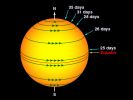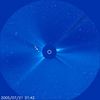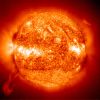The Sun: just a star, like many others...
|
|
|

Solar_rotation.jpgThe "uneven" Solar Rotation130 visitenessun commentoMareKromium
|
|

Sun & Comet (2).jpgA comet approaching the Sun (from SOHO)59 visiteCaption NASA originale:"SOHO, the space-based SOlar and Heliospheric Observatory, has become by far the reigning champion facility for discovering comets, its total having reached more than 200. As might be expected of a solar observatory, most of the SOHO discovered comets are "sungrazers", such as comets destined to dive within a mere 50.000 Km or so of the solar photosphere.
At that range the intense heat and gravitational forces make it unlikely these primitive chunks of ice and dust will survive".
|
|

Sun & Comet (dtl-mgnf).jpgA comet approaching the Sun (from SOHO) - detail mgnf53 visiteCaption NASA originale:"Based on their similar orbits, as first worked out by 19th century German astronomer Heinrich Kreutz, all "sungrazers" are believed to originate from a single large "parent comet" which broke up during a perihelion passage perhaps 2.000 years ago. Over time, pieces have continued to split off producing a family of smaller comets which seem to travel in the same orbit".
|
|

Sun & Comet.jpgA comet approaching the Sun (from SOHO)57 visiteCaption NASA originale:"These 3 frames from SOHO's coronograph were taken two hours apart from each other on April 29, 2000. They show a "sungrazer" (SOHO comet discovery number 111) with a long, bright tail headed toward its fiery encounter.
The Sun itself is hidden behind the coronograph's occulting disk at each frame's upper right".
|
|

Sun - Coronal holes.jpgCoronal "Holes"56 visiteCaption NASA originale:"The ominous, dark shapes haunting the left side of the Sun are coronal holes - low density regions extending above the surface where the solar magnetic field opens freely into interplanetary space. Studied extensively from space since the 1960s in ultraviolet and x-ray light, coronal holes are known to be the source of the high-speed solar wind, atoms and electrons which flow outward along the open magnetic field lines. During periods of low activity, coronal holes typically cover regions just above the Sun's poles. These coronal holes, however, have just moved into view near the Sun's equator, and particles escaping them have already caused notable aurora here on Earth. Coronal holes like this one may last for a few solar rotations before the magnetic fields shift and change configurations. Shown in false-color, this picture of the Sun on March 9, 2003, was made in extreme ultraviolet light by the EIT instrument on board the space-based SOHO observatory".
|
|

Sun filaments.jpgSun filaments58 visiteCaption NASA originale, da NASA Picture of the Day del 6 Dicembre 2004:"Two unusually long filaments crossed part of the Sun last week. The filaments are actually relatively cool and dark prominences of solar plasma held up by the Sun's magnetic field but seen against the face of the Sun. Filaments typically last a few weeks before falling back. Pictured above, the two filaments are visible on the Sun's right side. It would take twenty Earths, set end-to-end, to match the length of one of the filaments. Also visible are bright hot regions called plages and a carpet of hundreds of granules that provide the Sun's texture. The above image was taken early last week through a small telescope in a very specific color of light emitted primarily by hydrogen".
|
|

Sun surface in 3D.jpgThe "bubbling" surface of the Sun in 3D95 visiteCaption NASA originale" How smooth is the Sun? The new Swedish 1-m Solar Telescope, deployed in the Canary Islands in 2002, allows imaging of objects less than 100-Km across on the Sun's surface. When pointed toward the Sun's edge, surface objects now begin to block each other, indicating true three-dimensional information. Close inspection of the image reveals much vertical information, including spectacular light-bridges rising nearly 500 Km above the floor of sunspots near the top of the image. Also visible in the above false-color image are hundreds of bubbling granules, each about 1000 Km across, and small bright regions known as "faculae".
|
|

Sun-Equinox 2002.jpgThe Sun during the 2002 Equinox55 visiteCaption NASA originale:"The active Sun near the March Equinox, the beginning of Autumn in the south and Spring in the northern hemisphere. Recorded in a band of extreme ultraviolet light emitted by highly ionized iron atoms, the Sun's upper atmosphere (or solar corona) shines with an array of active regions and plasma loops suspended in magnetic fields. The bright coronal structures and loops seen here have temperatures of about 1.500.000° K".
|
|

Sun-PIA03149_modest.jpgSolar Flares from Soho79 visiteCaption NASA originale:"Extreme Ultraviolet Imaging Telescope (EIT) image of a huge, handle-shaped prominence taken on Sept. 14,1999 taken in the 304 angstrom wavelength - Prominences are huge clouds of relatively cool dense plasma suspended in the Sun's hot, thin corona. At times, they can erupt, escaping the Sun's atmosphere. Emission in this spectral line shows the upper chromosphere at a temperature of about 60,000 degrees K. Every feature in the image traces magnetic field structure. The hottest areas appear almost white, while the darker red areas indicate cooler temperatures".
|
|

Sun-Saturn-IMG001612-br500.jpgSaturn's "superior conjunction"54 visiteIn this SOHO image taken July 21, 2005, the Sun is represented by the white circle in the center. Saturn is the bright object to the left of the Sun. Interestingly, the streak accompanying Saturn is not the rings but a distortion caused by Saturn's brightness. Saturn is approaching "superior conjunction," that is, it will be almost directly behind the Sun from Earth - thus the Cassini spacecraft, in orbit around Saturn, will not be able to send or receive transmissions normally. Regular science data collection has been temporarily suspended.
As Cassini passes closest by the limb of the Sun on July 24 PDT, all the communications will be impossible because of the Sun's radio noise. The spacecraft will regain full communication with Earth on July 27, once again returning Saturn science data. In the meantime, controllers are sending approximately 100 commands per day to test communication status. Cassini radio scientists are taking advantage of this opportunity to study the Sun's corona from its effects on the radio signals that reach Earth.
SOHO (Solar and Heliospheric Observatory Satellite) orbits the Sun parked in one of the five gravitational-neutral spots, called Lagrange Points. This specific spot, called L1, stays in the same place relative to the Sun and the Earth, offering a continuously uninterrupted view of the Sun.
|
|

Sun-TRACE.jpgThe Sun from TRACE in ultra-violet light67 visiteCaption NASA originale:"Shown in ultraviolet light, the relatively cool dark regions have temperatures of thousands of degrees Celsius. Large sunspot group AR 9169 is visible as the bright area near the horizon. The bright glowing gas flowing around the sunspots has a temperature of over 1.000.000° C. The reason for the high temperatures is still unknown but thought to be related to the rapidly changing magnetic field loops that "channel" solar plasma.
Sunspot group AR 9169 moved across the Sun during September 2000 and decayed in a few weeks".
|
|

Sun-prom1743_eit_big.jpgAnother "Solar Prominence" from Soho77 visiteCaption NASA originale:"This large prominence is significant not only for its size, but also for its shape. The picture was taken early in the year 2000 by the Sun-orbiting SOHO satellite. Although large prominences and energetic Coronal Mass Ejections (CMEs) are relatively rare, they are occurred more frequently near Solar Maximum, such as the time of peak sunspot and solar activity in the 11 year solar cycle".
|
|
| 143 immagini su 12 pagina(e) |
 |
 |
 |
5 |  |
 |
 |
 |
 |
 |
|

